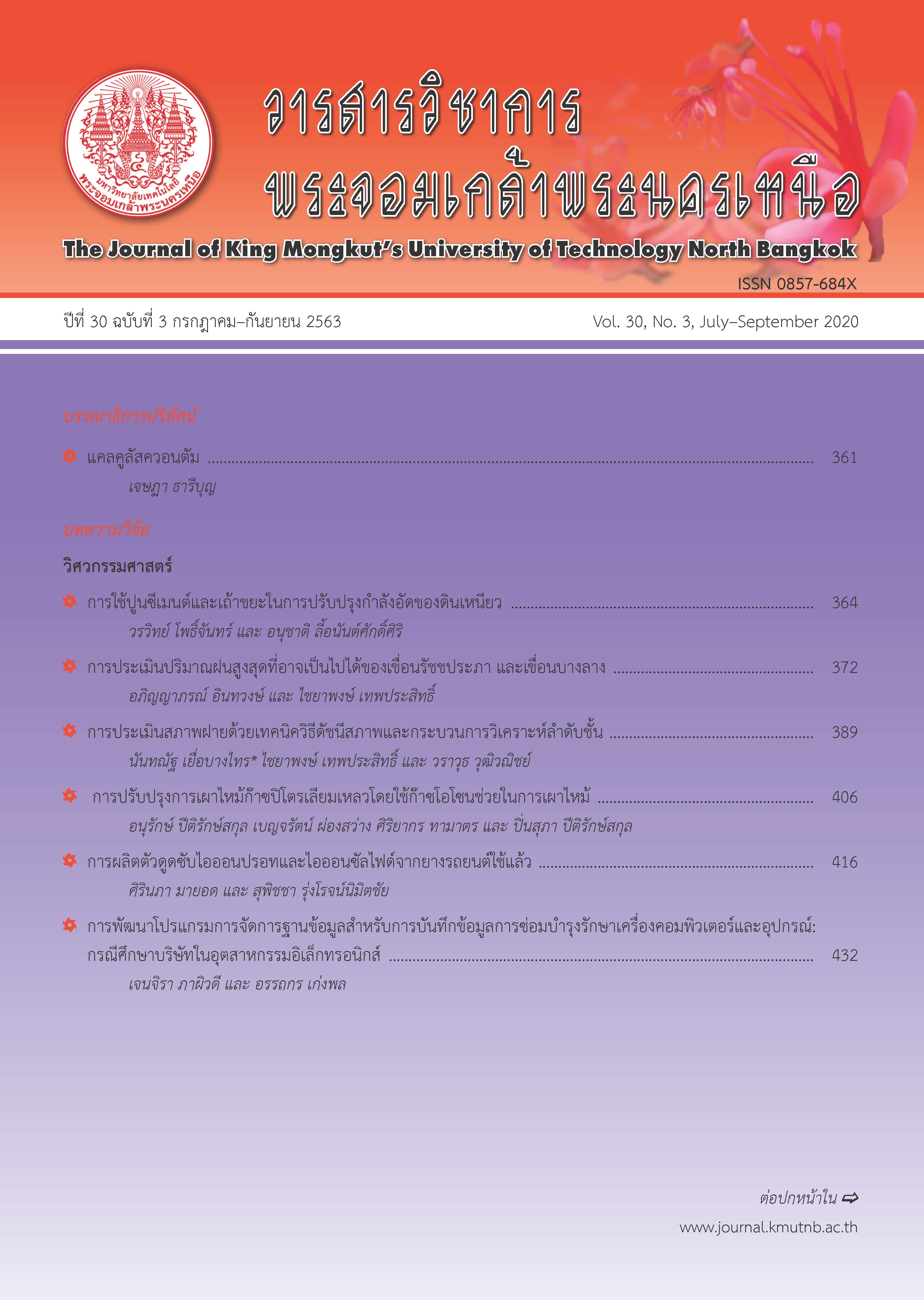การปรับปรุงความคงทนของสีและสมบัติการป้องกันรังสียูวีของผ้าฝ้ายเคลือบนาโนไคโตซานและซิงค์ออกไซด์ย้อมคราม
Main Article Content
บทคัดย่อ
วัสดุนาโนนาโนไคโตซานและนาโนซิงค์ออกไซด์สามารถปรับปรุงความคงทนของสีและสมบัติการป้องกันรังสียูวีของสิ่งทอได้ งานวิจัยนี้ศึกษาผ้าฝ้ายเคลือบด้วยอนุภาคนาโนไคโตซานและนาโนซิงค์ออกไซด์ย้อมคราม ทดสอบสัณฐานวิทยาของผ้าฝ้ายที่เคลือบอนุภาคนาโนไคโตซานและนาโนซิงค์ออกไซด์ด้วยกล้องจุลทรรศน์อิเล็กตรอนแบบส่องกราด (SEM) และพิสูจน์เอกลักษณ์ด้วยเครื่องฟูเรียร์ทรานฟอร์มอินฟราเรดสเปกโตรโฟโตมิเตอร์ (FT-IR) ทดสอบสมบัติการป้องกันรังสียูวี และความคงทนของสีต่อแสง และความคงทนของสีต่อการซักล้างของผ้าฝ้ายที่เคลือบ ผลการวิจัยพบว่า ผ้าฝ้ายที่ไม่เคลือบด้วยอนุภาคนาโนไคโตซาน และนาโนซิงค์ออกไซด์มีผิวหน้าที่เรียบ ผ้าฝ้ายที่เคลือบจะปรากฏอนุภาคนาโนไคโตซาน และนาโนซิงค์ออกไซด์ที่ผิวหน้าซึ่งช่วยเพิ่มพื้นที่ผิวสัมผัสให้เส้นใยดูดซับโมเลกุลสีย้อมได้มากขึ้น ความคงทนต่อแสง และความคงทนต่อการซักล้างของผ้าฝ้ายที่เคลือบย้อมคราม เฉลี่ยอยู่ในระดับ 4–5 (ดีถึงดีมาก) และ 4 (ดี) ตามลำดับ ผ้าฝ้ายเคลือบนาโนไคโตซาน (0.3 และ 0.5 กรัม) : นาโนซิงค์ออกไซด์ (1, 2 และ 3 กรัม) ย้อมคราม ทดสอบความคงทนต่อการซักล้างจำนวน 10, 20 และ 30 ครั้ง พบว่าความคงทนอยู่ในระดับ 4 (ดี) และสามารถป้องกันรังสียูวีได้ดีเยี่ยมด้วยค่า UPF ในช่วง 51.61–60.31
Article Details

อนุญาตภายใต้เงื่อนไข Creative Commons Attribution-NonCommercial-NoDerivatives 4.0 International License.
บทความที่ลงตีพิมพ์เป็นข้อคิดเห็นของผู้เขียนเท่านั้น
ผู้เขียนจะต้องเป็นผู้รับผิดชอบต่อผลทางกฎหมายใดๆ ที่อาจเกิดขึ้นจากบทความนั้น
เอกสารอ้างอิง
[2] V. R. Giri Dev, J. Venogopal, S. Sudha, G. Deepika, and S. Ramakrishna. “Dyeing and antimicrobrial charateristics of chitosan treated wool fabrics with henna dye,” Carbohydrate Polymers. vol. 75, no. 4, pp. 646–650, Feb. 2009.
[3] Cancer Council. (2019, Aug. 15). How ultraviolet (UV) radiation causes skin cancer. [Online]. Available: https://www.cancercouncil.com.au/63295/cancer-prevention/sunprotection/
[4] T.G. Smijis and S. Pavel. “Titanium dioxide and zinc oxide nanoparticles in sunscreens: focus on their safety and effectiveness,” Nanotechnol Sci Appl., vol. 4, pp 95–112, Oct. 2011.
[5] M. Montazer and M. M. Amiri, “ZnO nano reactor on textiles and polymers: Ex situ and in situ synthesis, application, and characterization,” J. Phys. Chem. B., vol. 118, pp. 1453–1470, Jan. 2014.
[6] S. Tangkawanit. “Development of silk dyeing natural dyes with nano ZnO paticles,” The 3rd International Thai Chemical Engineering and Applied Chemistry Conference. Oct. 17–18. 2013.
[7] S. Tangkawanit, “Dyeing of nano carbon and titanium dioxide coated monk robes using natural dye powder,” The Journal of KMUTNB, vol. 29, no. 1, pp. 145–156, Jan.–Mar. 2019 (in Thai).
[8] V. H. T. Thi and B. Lee. “Development of multifunctional self- cleaning and UV blocking cotton fabric with modification of photoactive ZnO coating via microwave method,” Korea, Vol. 338, pp. 13–22, Dec. 2017.
[9] K. F. El-tahlawy, M. A. El-bendary, A. G. Elhendawy, and S. M. Hudson “The antimicrobial activity of cotton fabrics treated with different crosslinking agents and chitosan,” Carbohydrate Polymers, vol. 60, pp. 421–430, Jun. 2005.
[10] L. H. Li, J. C. Deng, H. R. Deng, Z. L. Liu, and L. Xin. “Synthesis and characterization of chitosan/ ZnO nanoparticle composite membranes,” Carbohydrate Research. vol. 345, no. 8, pp. 994–998, May. 2010.
[11] Th. I. Shaheen, E. El. Mehrez, M. A. Abdelrahman, and A. Hebeish. “Durable antibacterial and UV protections of in situ synthesized Zinc oxide,” Nanoparticles onto Cotton Fabrics, Egypt, vol. 83, pp. 426-432, Feb. 2016.
[12] A. Farouk, S. Moussa, M. Ulbricht, and T. Textor. “ZnO nanoparticles-chitosan composite as antibacterial finish for textiles,” International Journal of Carbohydrate Chemistry, vol. 2012, pp. 1–8, Nov, 2012.
[13] K. Rejendran and T. Sivalingam. “Industrial method of cotton fabric finishing with chitosan-ZnO composite for anti-bacterial and thermal stability,” Industrial Crops and Products, vol.47, pp.160-167, May. 2013.
[14] A. Saithong, T. Wanruengrong, and U. Sunaprom. “The Development of indigo-dyed cloths’ pattern for the new generation people,” KKU Sci. J., vol. 40, No.2, pp. 423–435, Apr.–Jun. 2012 (in Thai).
[15] S. Laksanawadee, J. Setthayanond, T. Karpkird, T Bechtold, and P Suwanruji. “Green reducing agents for indigo dyeing on cotton fabrics,” Journal of Cleaner Production, vol. 197, pp. 106–113, Oct, 2018.
[16] P. Kaewnaree. “Reduction of heavy metals in industrial effluents by using chitosan from the black tiger shrimp shell,” Chiang Ma430.i, Graduate School, Chiang Mai University, 2000 (in Thai).
[17] M. M. AbdElhady “Preparation and characterization of chitosan/Zinc oxide nanoparticles for imparting antimicrobial and UV protection to cotton fabric,” International Journal of Carbohydrate Chemistry, vol 2012, pp. 1–6, Feb. 2012.
[18] C. Wang, Y. Ren, Q. Zhou, J. Chen, T. Zhi, Z. Lu, D. Gao, Z. Ma, and L. Jin. “Cotton fabric with plasma pretreatment and ZnO/Carboxymethyl chitosan composite finishing for durable UV resistance and antibacterial property,” Carbohydrate Polymers, vol. 138, no. 15, pp. 106–113, March 2016.
[19] R. Krishnaveni and S. Thambidurai, “Industrial method of cotton fabric finishing with chitosan–ZnO composite for anti-bacterial and thermal stability,” Industrial Crops and Products, vol. 47, pp. 160–67, Jan. 2013.
[20] M. Sundrarajan, R.R. Gandhi, A. Rukmani, S. Selvam, J. Suresh, and S. Gowri. “Chitosan and cyclodextrin modification on cellulosic fabric for enhanced natural dyeing,” Chemical Science Transactions, vol. 1, no. 2, pp. 440–446, May. 2012.
[21] V. R. Giri Dev, J. Venogopal, S. Sudha, G. Deepika, and S. Ramakrishna, “Dyeing and antimicrobrial charateristics of chitosan treated wool fabrics with henna dye,” Carbohydrate Polymers, vol. 75, pp. 646–650, Feb. 2009.
[22] D. Grifoni, L. Bacc, S. Di, L. Patrizia, Pi. Arianna, S. Francesca, C. Francesco, S. Gaetano, and Z. A, Romani, “UV protective properties of cotton and flax fabrics dyed with multifunctional plant extracts,” Dyes Pigments, vol. 105, pp. 89–96, Jun. 2014.

